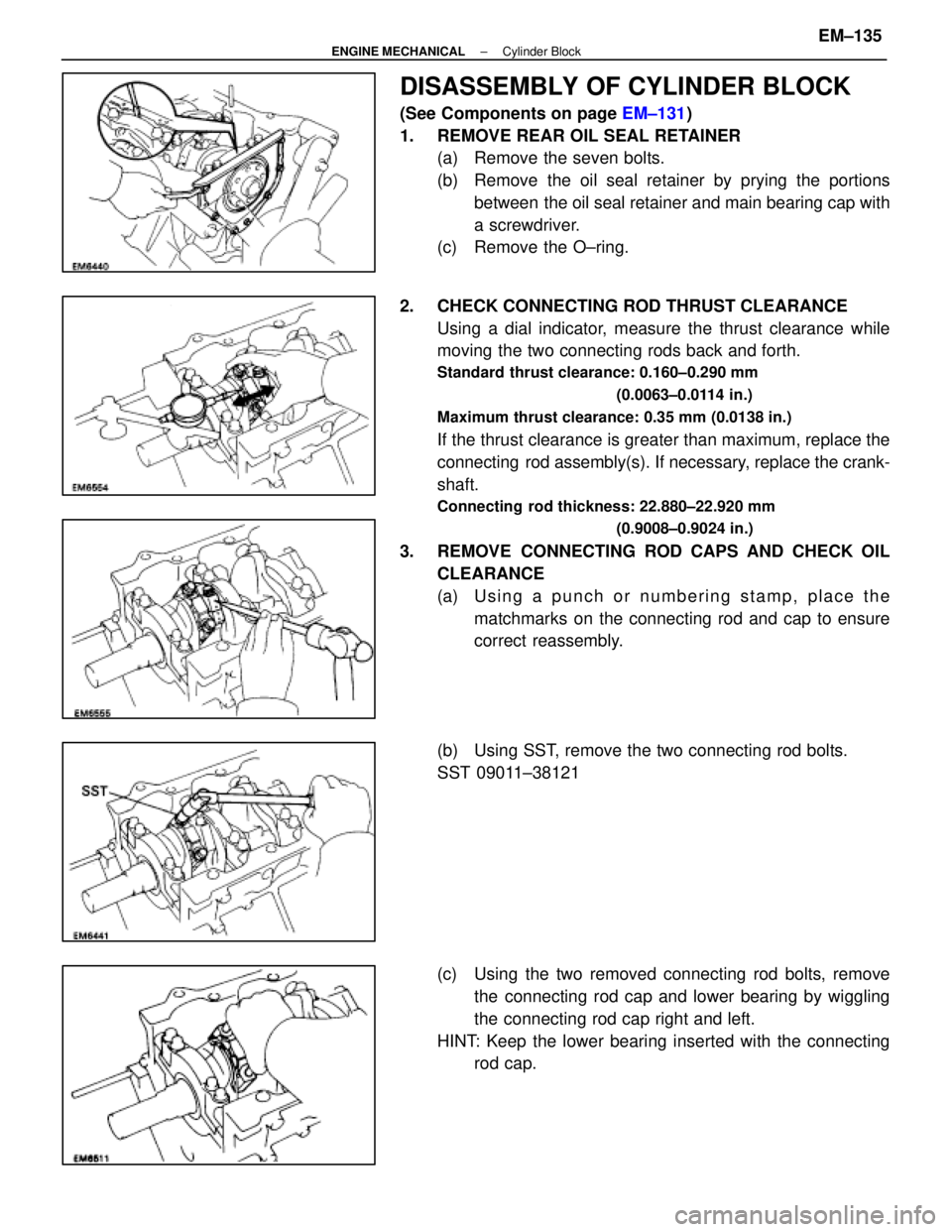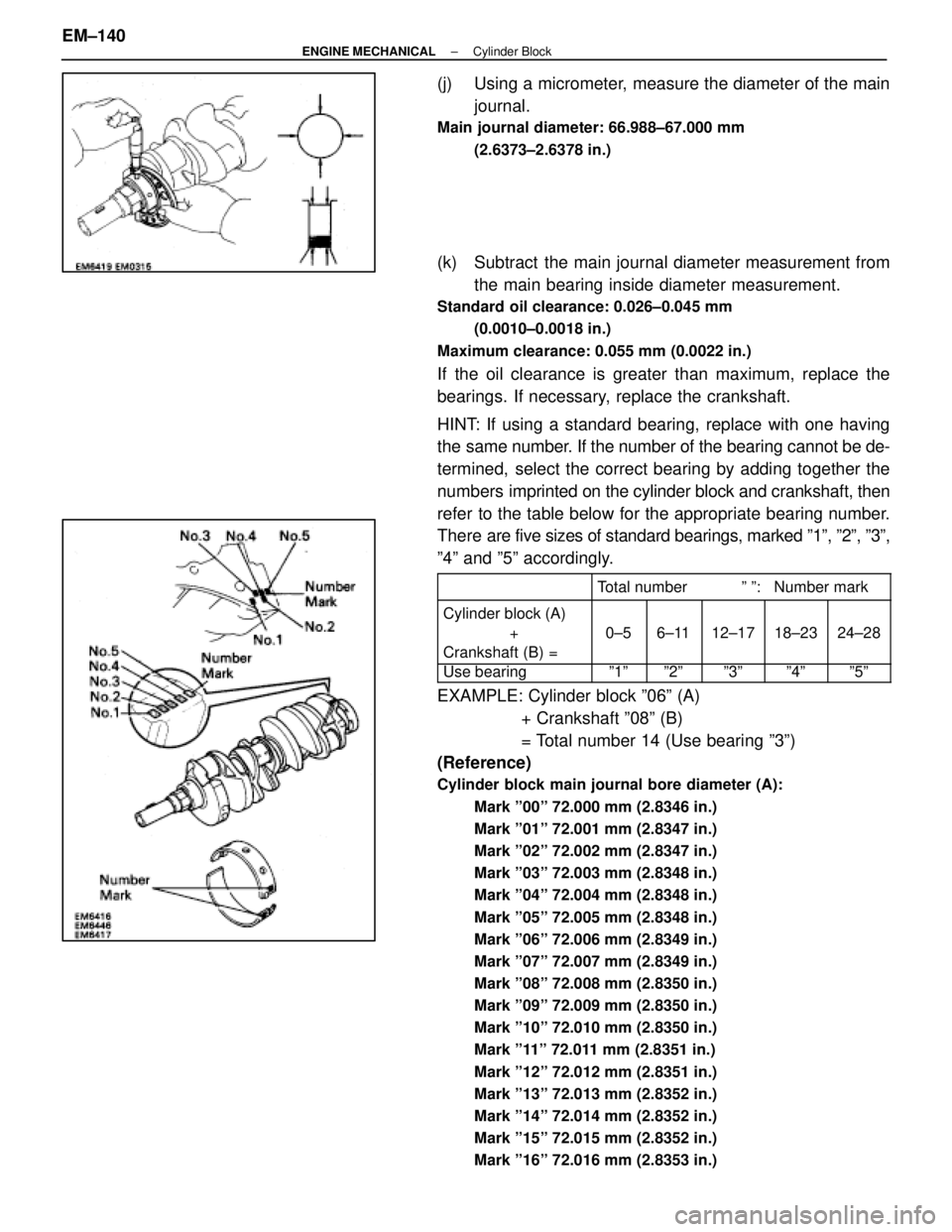Page 1598 of 4087
(b) Disconnect the wire clamp from the bracket on thestarter.
(c) Remove the nut, and disconnect the wire.
(d) Disconnect the connector, and remove the starter.
8. REMOVE KNOCK SENSORS (a) Disconnect the two knock sensor connectors.
(b) Using SST, remove the two knock sensors.
SST 09816±30010
9. REMOVE WATER BY±PASS PIPE (a) Remove the two bolts.
(b) Pull out the by±pass pipe from the water pump.
(c) Remove the O±ring from the by±pass pipe.
10. REMOVE ENGINE WIRE (a) Disconnect the following connectors:(1) Oil level sensor connector
(2) Oil pressure switch connector
(b) Remove the three bolts and wire cover from the LH side
of the cylinder block.
(c) Remove the two bolts and engine wire.
±
ENGINE MECHANICAL Cylinder BlockEM±133
WhereEverybodyKnowsYourName
Page 1599 of 4087
11. REMOVE WATER PUMP(a) Remove the five mounting bolt, two mounting stud boltsand mounting nut.
(b) Remove the water pump by prying the portions between
the water pump and cylinder block with a screwdriver.
12. REMOVE NO.2 AND NO.1 OIL PANS (See steps 7 to 12 on pages LU±9 to 11)
13. REMOVE OIL PUMP (a) Remove the eight mounting bolts.
(b) Remove the oil pump by prying the portions between the
oil pump and cylinder block with a screwdriver.
(c) Remove the O±ring from the cylinder block.
14. REMOVE ALTERNATOR BRACKET Remove the bolt and bracket.
15. REMOVE WATER SEAL PLATE
Remove the two nuts and seal plate.
EM±134
±
ENGINE MECHANICAL Cylinder Block
WhereEverybodyKnowsYourName
Page 1600 of 4087

DISASSEMBLY OF CYLINDER BLOCK
(See Components on page EM±131)
1. REMOVE REAR OIL SEAL RETAINER (a) Remove the seven bolts.
(b) Remove the oil seal retainer by prying the portions
between the oil seal retainer and main bearing cap with
a screwdriver.
(c) Remove the O±ring.
2. CHECK CONNECTING ROD THRUST CLEARANCE Using a dial indicator, measure the thrust clearance while
moving the two connecting rods back and forth.
Standard thrust clearance: 0.160±0.290 mm
(0.0063±0.0114 in.)
Maximum thrust clearance: 0.35 mm (0.0138 in.)
If the thrust clearance is greater than maximum, replace the
connecting rod assembly(s). If necessary, replace the crank-
shaft.
Connecting rod thickness: 22.880±22.920 mm (0.9008±0.9024 in.)
3. REMOVE CONNECTING ROD CAPS AND CHECK OILCLEARANCE
(a) Using a punch or numbering stamp, place thematchmarks on the connecting rod and cap to ensure
correct reassembly.
(b) Using SST, remove the two connecting rod bolts.
SST 09011±38121
(c) Using the two removed connecting rod bolts, remove the connecting rod cap and lower bearing by wiggling
the connecting rod cap right and left.
HINT: Keep the lower bearing inserted with the connecting rod cap.
±
ENGINE MECHANICAL Cylinder BlockEM±135
WhereEverybodyKnowsYourName
Page 1601 of 4087
(d) Clean the crank pin and bearings.
(e) C h e c k t h e c r a n k p i n a n d b e a r i n g f o r p i t t i n g a n dscratches.
If the crank pin or bearing are damaged, replace the bear-
ings. If necessary, replace the crankshaft.
(f) Lay a strip of Plastigage across the crank pin.
(g) Install the connecting rod cap with the two bolts.
(See step 6 on pages EM±159 and 160)
Torque: 1st 25 N Vm (250 kgf Vcm, 18 ft Vlbf)
2nd Turn 90 5
NOTICE: Do not turn the crankshaft.
(h) Remove the two bolts, connecting rod cap and lower
bearing. (See procedure (b) and (c) above)
(i) Measure the Plastigage at widest point.
Standard oil clearance: 0.027±0.053 mm (0.0011±0.0021 in.)
Maximum oil clearance: 0.065 mm (0.0026 in.)
If the oil clearance is greater than maximum, replace the
bearings. If necessary, replace the crankshaft.
EM±136
±
ENGINE MECHANICAL Cylinder Block
WhereEverybodyKnowsYourName
Page 1603 of 4087
HINT:
wKeep the bearings, connecting rod and cap together.
w Arrange the piston and connecting rod assemblies in
correct order.
5. CHECK CRANKSHAFT THRUST CLEARANCE Using a dial indi cator, measure the thrust clearance while pry-
ing the crankshaft back and forth with a screwdriver.
Standard thrust clearance: 0.020±0.220 mm
(0.0008±0.0087 in.)
Maximum thrust clearance: 0.30 mm (0.0118 in.)
If the thrust clearance is greater than maximum, replace the
thrust washers as a set.
Thrust washer thickness: 2.440±2.490 mm (0.0961±0.0980 in.)
6. REMOVE MAIN BEARING CAP AND CHECK OILCLEARANCE
(a) Remove the ten main bearing cap bolts.
(b) Uniformly loosen and remove the twenty main bearingcap nuts in several passes in the sequence shown.
EM±138
±
ENGINE MECHANICAL Cylinder Block
WhereEverybodyKnowsYourName
Page 1605 of 4087

(j) Using a micrometer, measure the diameter of the mainjournal.
Main journal diameter: 66.988±67.000 mm
(2.6373±2.6378 in.)
(k) Subtract the main journal diameter measurement fromthe main bearing inside diameter measurement.
Standard oil clearance: 0.026±0.045 mm
(0.0010±0.0018 in.)
Maximum clearance: 0.055 mm (0.0022 in.)
If the oil clearance is greater than maximum, replace the
bearings. If necessary, replace the crankshaft.
HINT: If using a standard bearing, replace with one having
the same number. If the number of the bearing cannot be de-
termined, select the correct bearing by adding together the
numbers imprinted on the cylinder block and crankshaft, then
refer to the table below for the appropriate bearing number.
There are five sizes of standard bearings, marked º1º, º2º, º3º\
,
º4º and º5º accordingly.
������� �
������
�������
�������������� �
�������������
��������������Total number º º: Number mark
������� �������Cylinder block (A)���� ������� ������ ������� �������� ����
�������+����0±5���6±11���12±17����18±23����24±28������� �������Crankshaft (B) =���� ������� ������ ������� �������� ����
������� �������Use bearing���� ����º1º��� ���º2º��� ���º3º���� ����º4º���� ����º5º
EXAMPLE: Cylinder block º06º (A)
+ Crankshaft º08º (B)
= Total number 14 (Use bearing º3º)
(Reference)
Cylinder block main journal bore diameter (A):
Mark º00º 72.000 mm (2.8346 in.)
Mark º01º 72.001 mm (2.8347 in.)
Mark º02º 72.002 mm (2.8347 in.)
Mark º03º 72.003 mm (2.8348 in.)
Mark º04º 72.004 mm (2.8348 in.)
Mark º05º 72.005 mm (2.8348 in.)
Mark º06º 72.006 mm (2.8349 in.)
Mark º07º 72.007 mm (2.8349 in.)
Mark º08º 72.008 mm (2.8350 in.)
Mark º09º 72.009 mm (2.8350 in.)
Mark º10º 72.010 mm (2.8350 in.)
Mark º11º 72.011 mm (2.8351 in.)
Mark º12º 72.012 mm (2.8351 in.)
Mark º13º 72.013 mm (2.8352 in.)
Mark º14º 72.014 mm (2.8352 in.)
Mark º15º 72.015 mm (2.8352 in.)
Mark º16º 72.016 mm (2.8353 in.)
EM±140±
ENGINE MECHANICAL Cylinder Block
WhereEverybodyKnowsYourName
Page 1609 of 4087

6. INSPECT MAIN BEARING CAP STUD BOLTSUsing a vernier caliper, measure the tension portion diameter
of the stud bolt.
Standard diameter: 7.500±7.600 mm
(0.2953±0.2992 in.)
Minimum diameter: 7.40 mm (0.2913 in.)
If the diameter is less than minimum, replace the stud bolt.
7. IF NECESSARY, REPLACE MAIN BEARING CAP STUD BOLTS
(a) Using the two main bearing cap nuts, remove the studbolt.
(b) Apply a light coat of engine oil on the threads and under
the flange of the stud bolt.
(c) Using the two main bearing cap nuts, install and torque
the stud bolt.
Torque: 10 N Vm (100 kgf Vcm, 7 ft Vlbf)
HINT: Stud bolts come in lengths of 90.0 mm (3.543 in.) and
101.5 mm (3.996 in.). Install the 101.5 mm (3.996 in.) bolts
in inside positions. Install the 90.0 mm (3.543 in.) bolts in out-
side positions.
DISASSEMBLY OF PISTON AND
CONNECTING ROD ASSEMBLIES
1. CHECK FIT BETWEEN PISTON AND PISTON PIN
Try to move the piston back and forth on the piston pin.
If any movement is felt, replace the piston and pin as a set.
EM±144
±
ENGINE MECHANICAL Cylinder Block
WhereEverybodyKnowsYourName
Page 1610 of 4087
2. REMOVE PISTON RINGS(a) U s i n g a p i s t o n r i n g e x pander, remove the two
compression rings.
(b) Remove the two side rails and oil ring expander by hand.
HINT: Arrange the piston rings in correct order only.
3. DISCONNECT CONNECTING ROD FROM PISTON (a) Using a small screwdriver, pry out the two snap rings.
(b) Gradually heat the piston to approx. 60 °C (140 °F).
(c) Using a plastic±face hammer and brass bar, lightly tap out the piston pin and remove the connecting rod.
±
ENGINE MECHANICAL Cylinder BlockEM±145
WhereEverybodyKnowsYourName